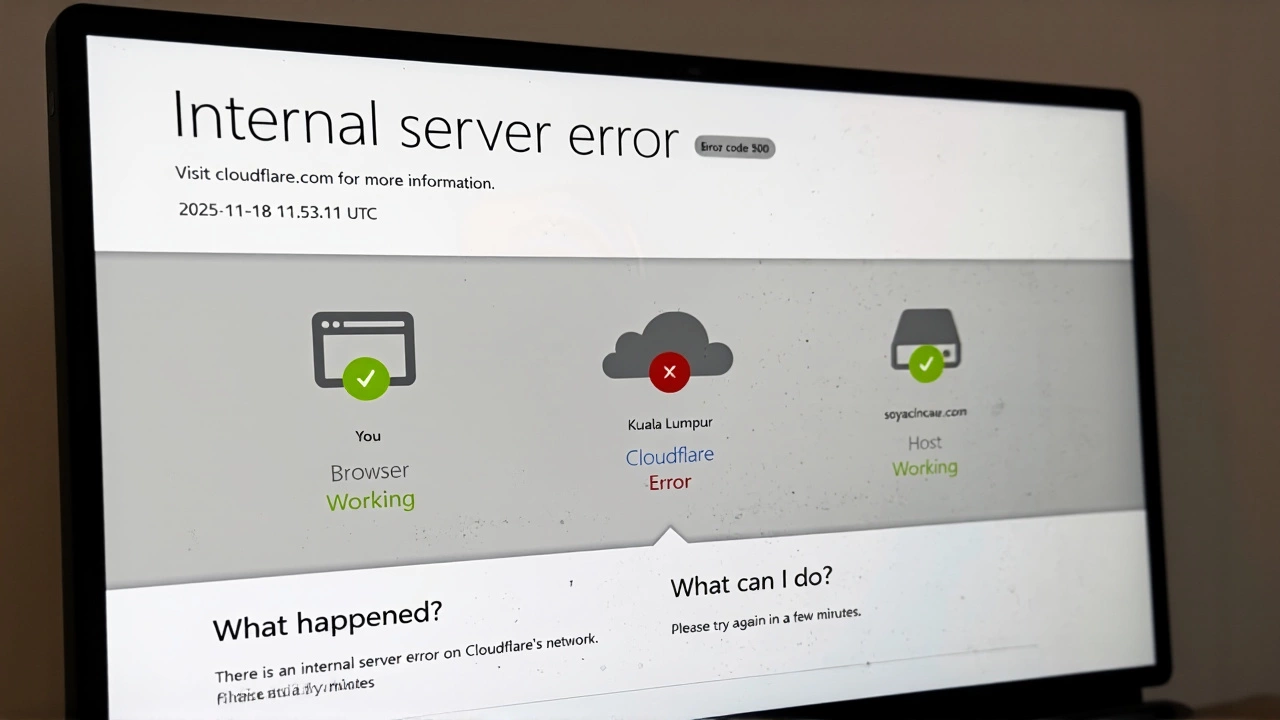At 11:48 UTC on November 18, 2025, the internet hiccuped — then staggered. Millions of users across North America, Europe, and Asia found themselves staring at blank screens, error messages, and silent feeds as Cloudflare Inc., the invisible backbone of the modern web, went dark. For two hours, X (formerly Twitter) showed empty timelines and "super unhelpful internal server error" pop-ups. OpenAI's ChatGPT locked users out with "Access denied" messages. Meta's Facebook, Spotify, and Canva all blinked out. Even Downdetector, the very tool meant to track outages, went offline. This wasn’t a glitch. It was a systemic collapse — and it started with one company.
How One Company Broke the Internet
Cloudflare Inc. doesn’t own websites. It doesn’t make apps. But it protects, accelerates, and routes traffic for nearly one in five websites globally — including giants like X, ChatGPT, and Spotify. According to W3Techs data from 2025, Cloudflare serves 27% of all websites. When it stumbles, the whole web feels it.The trouble began during scheduled maintenance at data centers in Santiago (SCL), Tahiti (PPT), and Los Angeles (LAX). An issue with Cloudflare’s support portal provider escalated into a cascade failure within its Durable Objects and internal API services. These are the quiet engines that handle real-time data persistence and internal communications across Cloudflare’s global network. When they overloaded, HTTP 500 errors exploded like fireworks — hitting every site that relied on Cloudflare’s infrastructure.
By 13:09 UTC, engineers had begun rerouting traffic. Cloudflare’s status page confirmed: "We have implemented a fix for the issue causing 5xx errors." But recovery wasn’t instant. Users in New York, Berlin, and Mumbai kept seeing errors for another 45 minutes. The company warned that "customers may continue to observe higher-than-normal error rates as we continue remediation efforts." It was like turning off a fire alarm — the flames were out, but smoke still lingered.
Who Got Hit — And How Badly?
Downdetector logged over 11,500 reports of X being down by 5:15 PM IST. The breakdown? 47% of users couldn’t load their feeds. 30% couldn’t interact with the site. 23% couldn’t even connect to servers. ChatGPT users reported being completely locked out — no login, no chat, no fallback. Even League of Legends players saw matchmaking timeouts. Spotify streams dropped. Canva’s design tools froze mid-project. For many, it wasn’t just inconvenience — it was lost work, missed deadlines, broken workflows.
What made this worse? Timing. The outage coincided with peak usage hours in Europe and Asia. In India, where 400 million+ internet users rely on X for news and commerce, the disruption lasted through the afternoon rush. In the U.S., businesses using Cloudflare-hosted e-commerce platforms lost sales. One small business owner in Portland told me, "I had five orders come through during the outage — but customers saw errors. They left. I didn’t even know until hours later. No one told me.”
The Fragility of the Digital Foundation
This wasn’t the first time Cloudflare had an outage — but it was the biggest since July 2024. And it’s the clearest signal yet that the internet’s architecture has become dangerously centralized. We’ve built a digital world that depends on a handful of companies: Cloudflare, Amazon Web Services, Google Cloud, Microsoft Azure. When one falters, the whole house shakes.
"This global disruption is a severe stress test," said Dr. Elena Torres, a network resilience expert at MIT. "We treat these providers like utilities — but they’re private companies with profit motives, not public infrastructure with backup mandates. When Cloudflare slows down, the internet slows down. That’s not a feature. It’s a flaw."
Experts are now pushing for "diversity and redundancy" — a phrase that sounds simple but demands radical change. Businesses can’t just use one CDN. They need secondary providers. Developers can’t rely on one API. They need fail-safes. Governments? They need to treat core internet infrastructure like power grids — with mandatory resilience standards.

What Happens Next?
Cloudflare says it’s monitoring for residual errors. No public apology from CEO Matthew Prince yet — though he’s known for being unusually transparent during crises. His silence speaks volumes. Meanwhile, competitors like Fastly and Akamai are quietly fielding calls from panicked clients.
What’s next? Expect more regulatory scrutiny. The European Commission is already reviewing whether critical infrastructure providers like Cloudflare should be designated "systemically important." In the U.S., the FCC may revisit its stance on internet backbone oversight. And startups? They’re rushing to build decentralized alternatives — not just for fun, but for survival.
The truth? We’ve outsourced our digital safety to a few overworked engineers in San Francisco. And when they’re overwhelmed, we all pay the price.
Frequently Asked Questions
How many websites were affected by the Cloudflare outage?
Approximately 20% of all websites globally experienced disruptions during the November 18, 2025 outage, according to traffic analysis firms. This translates to roughly 180 million sites relying on Cloudflare’s infrastructure, including major platforms like X, ChatGPT, and Spotify. Even sites not directly down suffered from slower load times due to network congestion.
Why did Cloudflare’s own dashboard go down during the outage?
Cloudflare’s status page and API services are hosted on its own network — meaning they depended on the same Durable Objects and internal APIs that failed. When the overload hit, even the tools meant to diagnose the problem became unusable. This created a feedback loop: users couldn’t check the status, so they kept refreshing, which worsened the traffic surge.
What’s the difference between this outage and Cloudflare’s July 2024 incident?
The July 2024 outage was caused by a misconfigured firewall rule affecting a single region. The November 2025 incident originated from a cascading failure in core infrastructure — Durable Objects and internal APIs — impacting global traffic simultaneously. This one was deeper, broader, and more systemic, exposing architectural vulnerabilities rather than operational errors.
Should businesses stop using Cloudflare?
No — but they should diversify. Cloudflare remains the most cost-effective and powerful CDN for most businesses. The lesson isn’t to abandon it, but to layer redundancy: use a secondary provider for critical functions, implement local caching, and design for partial failures. Many enterprises now run dual-CDN setups — it’s no longer a luxury, it’s a necessity.
How long did the outage last, and when did services fully recover?
The core outage lasted about two hours, from 11:48 UTC to 13:48 UTC. Cloudflare announced a fix at 13:09 UTC, but full normalization took until 15:30 UTC. Residual errors, especially on mobile apps and cached content, persisted for several more hours in some regions, particularly in Asia and Latin America.
What’s being done to prevent this from happening again?
Cloudflare has committed to redesigning its internal API routing logic and adding stricter traffic throttling for its support portal integrations. Industry analysts expect new regulatory proposals in 2026 to require critical infrastructure providers to maintain independent monitoring systems and publish quarterly resilience reports. For now, the burden falls on customers to demand redundancy.
